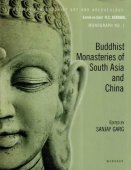Ray: 12 definitions
Introduction:
Ray means something in Hinduism, Sanskrit, Hindi, biology. If you want to know the exact meaning, history, etymology or English translation of this term then check out the descriptions on this page. Add your comment or reference to a book if you want to contribute to this summary article.
In Hinduism
Yoga (school of philosophy)
Source: ORA: Amanaska (king of all yogas): A Critical Edition and Annotated Translation by Jason Birch1) Rays (of Light) can be denoted by the Sanskrit term Go, according to the Amanaska Yoga treatise dealing with meditation, absorption, yogic powers and liberation.—Accordingly, as Īśvara says to Vāmadeva: “[...] [Now], I shall define the nature of that highest, mind-free absorption which arises for those devoted to constant practice. [...] By means of an absorption for half a day, the light of his own self shines. Just like the sun shines forth with its [own] rays of light (go), the Yogin shines forth [and illuminates] the world. [...]”.
2) A Ray (of Light) is denoted by the Sanskrit term Raśmi, according to the Bhāṣya (commentary) on the Pātañjalayogaśāstra Sūtra 3.42.—Accordingly, “... [The yogin] who has mastered the connection [between body and space] becomes light. Because he is light, he can walk on water. Then, having walked on merely a spider’s thread, he walks on a ray of light (raśmi). Then, he moves in the ether as he wishes”.

Yoga is originally considered a branch of Hindu philosophy (astika), but both ancient and modern Yoga combine the physical, mental and spiritual. Yoga teaches various physical techniques also known as āsanas (postures), used for various purposes (eg., meditation, contemplation, relaxation).
Biology (plants and animals)
Source: Google Books: CRC World Dictionary (Regional names)Ray in Vietnam is the name of a plant defined with Alocasia macrorrhizos in various botanical sources. This page contains potential references in Ayurveda, modern medicine, and other folk traditions or local practices It has the synonym Arum montanum Roxb. (among others).
Example references for further research on medicinal uses or toxicity (see latin names for full list):
· Index Seminum [Berlin]
· Histoire Naturelle des Végétaux—Phanérogames (Tome) (1846)
· Description des Plantes Nouvelles … Jardin de J.M. Cels (1801)
· Species Plantarum (1753)
· Bot. Reg. (1822)
· Hortus Britannicus (1839)
If you are looking for specific details regarding Ray, for example chemical composition, extract dosage, health benefits, side effects, pregnancy safety, diet and recipes, have a look at these references.

This sections includes definitions from the five kingdoms of living things: Animals, Plants, Fungi, Protists and Monera. It will include both the official binomial nomenclature (scientific names usually in Latin) as well as regional spellings and variants.
Languages of India and abroad
Sanskrit dictionary
Source: DDSA: The practical Sanskrit-English dictionaryRay (रय्).—1 Ā. (rayate, rayita) To go, move.
Source: Cologne Digital Sanskrit Dictionaries: Shabda-Sagara Sanskrit-English DictionaryRay (रय्).—r. 1st cl. (rayate) To go, to move.
Source: Cologne Digital Sanskrit Dictionaries: Benfey Sanskrit-English DictionaryRay (रय्).—lay Lay, i. 1, [Ātmanepada.] To go.
Source: Cologne Digital Sanskrit Dictionaries: Monier-Williams Sanskrit-English DictionaryRay (रय्):—(cf. √lay) [class] 1. [Ātmanepada] rayate, to go, [Dhātupāṭha xiv, 10.]
Source: Cologne Digital Sanskrit Dictionaries: Yates Sanskrit-English DictionaryRay (रय्):—(ṅa) rayate 1. d. To go.
[Sanskrit to German]
Sanskrit, also spelled संस्कृतम् (saṃskṛtam), is an ancient language of India commonly seen as the grandmother of the Indo-European language family (even English!). Closely allied with Prakrit and Pali, Sanskrit is more exhaustive in both grammar and terms and has the most extensive collection of literature in the world, greatly surpassing its sister-languages Greek and Latin.
Hindi dictionary
Source: DDSA: A practical Hindi-English dictionaryRay in Hindi refers in English to:—(nf) opinion, view; advice; (nm) a king; —[kayama karana] to form an opinion; —[mamgana] to seek the advice of; —[milana] to see eye to eye; —[milana] to compare notes, to exchange views..—ray (राय) is alternatively transliterated as Rāya.
...
Kannada-English dictionary
Source: Alar: Kannada-English corpusRay (ರಯ್):—[noun] an abundance of riches; wealth; opulence; affluence.
Kannada is a Dravidian language (as opposed to the Indo-European language family) mainly spoken in the southwestern region of India.
Nepali dictionary
Source: unoes: Nepali-English DictionaryRaay is another spelling for राय [rāya].—n. 1. opinion; idea; thought; principle; theory; judgment; view; 2. suggestion; advice; counsel;
Nepali is the primary language of the Nepalese people counting almost 20 million native speakers. The country of Nepal is situated in the Himalaya mountain range to the north of India.
See also (Relevant definitions)
Starts with (+198): Ray dai, Ray grass, Raya, Raya raghava, Raya ramashankara, Raya-balsa, Raya-dekhaunu, Raya-katnu, Raya-rauta, Raya-rekha, Rayaamvala, Rayabajhai, Rayabajho, Rayabajho-phaisala, Rayabhara, Rayabharaka, Rayabhari, Rayabharitana, Rayabhati, Rayabhatta.
Ends with (+195): Abhimantray, Abhipray, Abhray, Adharay, Aharay, Ahvaray, Ajiray, Akshigocaray, Alaray, Amantray, Amishray, Amitray, Ankuray, Antaray, Antray, Anumantray, Apsaray, Aray, Ardray, Ashray.
Full-text (+396): Rashmi, Mayukha, Kirana, Amshu, Arcis, Viroka, Gabhasti, Marici, Ghrini, Usra, Agrakara, Agramshu, Prishni, Syona, Vibha, Syuma, Dhrishni, Didhiti, Tvishi, Arka.
Relevant text
Search found 141 books and stories containing Ray, Raay; (plurals include: Raies, Raaies). You can also click to the full overview containing English textual excerpts. Below are direct links for the most relevant articles:
Vaishnava Janato < [October – December, 1997]
Remembering Prof. Sib Ray: The Radical < [July – September, 2008]
Sudhansu Kumar Ray: An Artist-Craftsman of Bengal < [September-October 1932]
Ksitigarbha Bodhisattva fundamental vow sutra (by Johnny Yu)
The Linga Purana (by J. L. Shastri)
Chapter 60 - The Solar Sphere < [Section 1 - Uttarabhāga]
Chapter 12 - The cosmic form of Śiva < [Section 2 - Pūrvabhāga]
Chapter 56 - Description of the Moon (soma-varṇana) < [Section 1 - Uttarabhāga]
The Sutra of the Past Vows of Earth Store Bodhisattva
Rig Veda (translation and commentary) (by H. H. Wilson)
Chaitanya's Life and Teachings (by Krishna-das Kaviraj)
Related products

